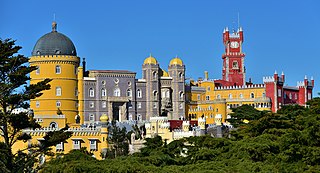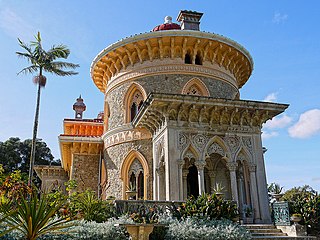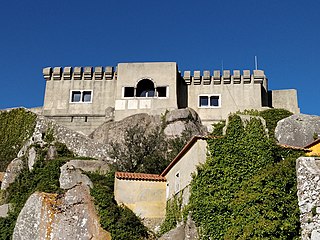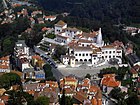
Sintra is a town and municipality in the Greater Lisbon region of Portugal, located on the Portuguese Riviera. The population of the municipality in 2021 was 385,654, in an area of 319.23 square kilometres (123.26 sq mi). Sintra is one of the most urbanized and densely populated municipalities of Portugal. A major tourist destination famed for its picturesqueness, the municipality has several historic palaces, castles, scenic beaches, parks and gardens.

The Pena Palace is a Romanticist castle in São Pedro de Penaferrim, in the municipality of Sintra, on the Portuguese Riviera. The castle stands on the top of a hill in the Sintra Mountains above the town of Sintra, and on a clear day it can be easily seen from Lisbon and much of its metropolitan area. It is a national monument and constitutes one of the major expressions of 19th-century Romanticism in the world. The palace is a UNESCO World Heritage Site and one of the Seven Wonders of Portugal. It is also used for state occasions by the President of the Portuguese Republic and other government officials.

The Sintra Mountains, is a mountain range in western Portugal. Its highest point is at 529 meters (1,736 ft) near Sintra. The range covers about 16 kilometers (10 mi) from the resort town of Sintra to Cabo da Roca(Cape Roca) on the Atlantic Ocean. It was known to the Ancient World as Lunae Mons and was the legendary retreat of Diana the Huntress.

Luigi Pietro Manini, Count of Fagagna was an Italian set designer, architect, painter. He arrived in Lisbon, Portugal in 1879, where he lived until he returned to Italy in 1913. Manini was responsible for some of the most striking architectural designs in Portugal; some of his most famous works include:

The Monserrate Palace is a palatial villa located near Sintra, the traditional summer resort of the Portuguese court in the foothills overlooking the Atlantic Ocean north of the capital, Lisbon.
Neo-Mudéjar is a type of Moorish Revival architecture practised in the Iberian Peninsula and to a far lesser extent in Ibero-America. This architectural movement emerged as a revival of Mudéjar style. It was an architectural trend of the late 19th and early 20th centuries that began in Madrid and Barcelona and quickly spread to other regions in Spain and Portugal. It used Mudéjar style elements such as the horseshoe arch, arabesque tiling, and abstract shaped brick ornamentations for the façades of modern buildings.

The Sintra-Cascais Natural Park is a park on the Portuguese Riviera, one of the 13 Natural Parks of Portugal. While only established in 1994 as a Natural Park by the Portuguese Government, it has been protected since 1981. Its area is approximately 145 km2. The park includes the Serra de Sintra Mountain Range but extends all the way to the coast and Cabo da Roca, continental Europe's westernmost point. It contains the Castle of the Moors. Located within 25 km of Lisbon, the Sintra-Cascais Natural Park is a popular tourism area, with many different individual historical and natural sites and attractions. Sintra and Cascais are towns and municipalities in the Lisbon / Estoril Coast.

Portuguese architecture refers to both the architecture of Portugal's modern-day territory in Continental Portugal, the Azores and Madeira, as well as the architectural heritage/patrimony of Portuguese architects and styles throughout the world, particularly in countries formerly part of the Portuguese Empire.

António Augusto Carvalho Monteiro, also known as Monteiro dos Milhões, was a Brazilian-Portuguese businessman, collector, bibliophile, entomologist and Freemason. His largesse created the Quinta da Regaleira.

The Pousada of D. Maria is part of the Pousadas de Portugal network of lodgings, housed in the historical servants quarters/annex of the Queluz National Palace, located in the civil parish of Queluz in the municipality of Sintra in the Portuguese sub-region of Greater Lisbon.

Neo-Manueline is a revival style of architecture which drew from the 16th century Manueline Late Gothic architecture of Portugal. Neo-Manueline constructions have been built across Portugal, Brazil, and the Lusophone world.

Quinta da Regaleira is a quinta located near the historic centre of Sintra, Portugal. It is classified as a World Heritage Site by UNESCO within the "Cultural Landscape of Sintra". Along with the other palaces in the area such as the Quinta do Relógio, Pena, Monserrate and Seteais palaces, it is considered one of the principal tourist attractions of Sintra.

The Archaeological Site of Alto da Vigia is an archaeological site associated with Roman interventions in the Portugal, situated along the Praia das Maçãs in the civil parish of São João das Lampas e Terrugem, in municipality of Sintra.

The Castle of the Moors is a hilltop medieval castle located in the central Portuguese civil parish of Santa Maria e São Miguel, in the municipality of Sintra, about 25 km (16 mi) northwest of Lisbon. Built by the Moors in the 8th and 9th centuries, it was an important strategic point during the Reconquista, and was taken by Christian forces after the fall of Lisbon in 1147. It is classified as a National Monument, part of the Sintra Cultural Landscape, a UNESCO World Heritage Site.

The Portuguese Riviera is a term used in the tourist industry for the affluent coastal region to the west of Lisbon, Portugal, centered on the coastal municipalities of Cascais, Oeiras and Sintra. It is coterminous with the Estoril Coast and occasionally known as the Costa do Sol. Portuguese themselves do not use this expression.

Quinta is a traditional term for an estate, primarily used in Portugal and the Portuguese-speaking world, but the term has sometimes been borrowed in non-Portuguese speaking countries of Ibero-America.

The Sanctuary of Peninha is situated in the Sintra Mountains in the Sintra-Cascais Natural Park, in the Lisbon District of Portugal. It stands at an altitude of 448 metres on top of a rocky outcrop, which provides views over the coastline and inland areas. In addition to a baroque chapel, completed in 1710, the location contains the Palace of Peninha, which dates from 1918, as well as remains of a hermitage. The interiors of neither the chapel nor the palace can presently be visited.

The Quinta da Ribafria is situated close to Sintra in Lisbon District, Portugal. It was built from 1536 to 1541 by Gaspar Gonçalves, a ceremonial official of the Portuguese Royal Household, on land donated to him by King Manuel I in 1515. The property is now owned by the Sintra Municipality.

Linhó is an affluent village in the municipality of Sintra, on the Portuguese Riviera, known for its resorts, restaurants, and its two prominent gated communities, Quinta da Penha Longa and Quinta da Beloura. Linhó is home to a large expatriate community, the only American school in Portugal, and has hosted a Bilderberg Meeting.






















